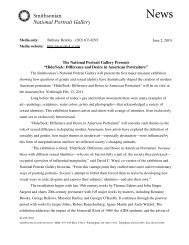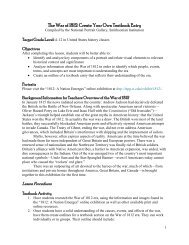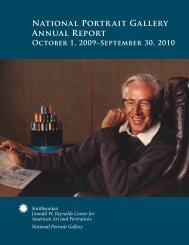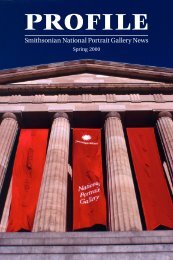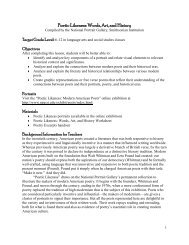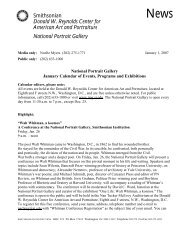Download this issue - National Portrait Gallery - Smithsonian Institution
Download this issue - National Portrait Gallery - Smithsonian Institution
Download this issue - National Portrait Gallery - Smithsonian Institution
Create successful ePaper yourself
Turn your PDF publications into a flip-book with our unique Google optimized e-Paper software.
PROFILE<strong>Smithsonian</strong> <strong>National</strong> <strong>Portrait</strong> <strong>Gallery</strong> NewsWinter 2002
From theDIRECTORBefore the second half of the twentiethcentury, few would have doubted thatindividuals play the critical role inshaping the key events of history. Butsince the end of World War II, somesee social forces predominating overthe will and action of individuals. Whilewelcoming all views of history, we at the <strong>National</strong> <strong>Portrait</strong> <strong>Gallery</strong> havecontinued to share with so many of our fellow citizens the belief thatindividuals can and do make a difference and that there must be a place inthe national life to recognize how remarkable and significant the passionsand achievements of one single person can be.Each <strong>issue</strong> of Profile makes <strong>this</strong> point about our national history, but<strong>this</strong> <strong>issue</strong> reminds us of yet another way that the <strong>Gallery</strong> benefits from thepower of remarkable individuals. Here, you will find accounts of threepeople who have made a difference in the <strong>Gallery</strong>’s capacity to serve theAmerican public: Paul Peck, Virginia Boochever, and Ruth Bowman. Inan era when attention has gone to the role of corporate and foundationphilanthropy—and thank heaven for that support—we need to rememberthat the conviction and generosity of individuals remains a bedrock of the“American way” of public service.At the time I am writing <strong>this</strong> letter we have just enjoyed an exhilaratingweekend devoted to the inauguration of the Paul Peck Presidential Awards.It is Paul’s conviction that we must inspire America’s younger generationsto an awareness of not only the privileges but also the responsibilities ofcitizenship in a democracy. These imperatives and obligations, he believes,are best understood through the drama of the presidency. The article tofollow will explain many aspects of the presidential initiative we havelaunched with his support, but I want here to convey the inspiration I feltwhile witnessing a full morning of amazing questions asked of awardeesBrent Scowcroft and Richard Neustadt by an array of students fromseveral East Coast states. For those who wish the best for our nation’sfuture, <strong>this</strong> was as good as it gets.Exciting, too, is our ability to influence and support the future ofportraiture because of the generosity of Virginia Boochever. Virginiarecognized how successful the <strong>National</strong> <strong>Portrait</strong> <strong>Gallery</strong> in Londonhas been in awakening an interest in figurative art among the talentedyoung artists of Britain, and she resolved to help our <strong>Gallery</strong> follow theirlead in creating a portrait competition. The Outwin Boochever <strong>Portrait</strong>Competition, which we are now shaping, has already elicited considerableinterest and will become, I know, one of the most important domains ofartistic recognition in our country and a cornerstone of the twenty-firstcentury<strong>Portrait</strong> <strong>Gallery</strong>.And finally, we have Ruth Bowman to thank for joining with her friend,the late Harry Kahn, in a search for an extraordinary array of Americanself-portraits and then finding a way, through the good offices of ourcurator of prints and drawings, Wendy Wick Reaves, to allow a generousdonative sale to NPG. This is the kind of collection we dream of, compiledthrough great taste and great passion.It has been a very good year.2
PROFILEContentsVol. 3. No. 4 Winter 20024The Bowman-KahnCollectionTwentieth-CenturySelf-<strong>Portrait</strong>s6Paul Peck PresidentialAwards8Historian’s ChoicePocahontas9Book ReviewStravinsky and Balanchine:A Journey of Invention byCharles M. Joseph10Boochever Gift to Fund<strong>National</strong> <strong>Portrait</strong>Competition11<strong>Portrait</strong> <strong>Gallery</strong>Sponsors Panel onPresidential Biography12 New Acquisitions14NPG on the Road15NPG Schedules andInformation16<strong>Portrait</strong> PuzzlersCover: The <strong>National</strong> <strong>Portrait</strong><strong>Gallery</strong>’s exhibition in London,“Americans” (titled “A Brushwith History” for its U.S. tour),provided an opportunity forformer Prime Minister BaronessMargaret Thatcher (shown withNPG Director Marc Pachter)and Prime Minister Tony Blairto celebrate Anglo-Americanfriendship.©Photographs ZownirIn the next <strong>issue</strong>• A special editiondevoted to modernportraiturePROFILE<strong>National</strong> <strong>Portrait</strong> <strong>Gallery</strong><strong>Smithsonian</strong> <strong>Institution</strong>750 Ninth Street, NWP.O. Box 37012 MRC 973Washington, DC 20013-7012Phone: (202) 275-1738Fax: (202) 275-1887E-mail: NPGnews@npg.si.eduWebsite: www.npg.si.eduReaders’ comments are welcome.To receive Profile, please sendyour name, home address, ande-mail address (if applicable) toNPGnews@npg.si.edu or thepost office box listed above.Unless otherwise noted, all images are fromthe <strong>National</strong> <strong>Portrait</strong> <strong>Gallery</strong> collection.©2002 <strong>Smithsonian</strong> <strong>Institution</strong>Available in alternative formats.Printed on recycled paperMarc PachterCarolyn CarrEloise BadenEditorCarol WyrickReview EditorSidney HartEditorial CommitteeAnne ChristiansenDru DowdyMarianne GurleyPatrick MaddenEllen G. MilesFrederick VossDesignLeslie LondonDirectorDeputy Director andChief CuratorChief Administrative OfficerOffice of EducationThe Charles Willson PealeFamily PapersOffice of Public AffairsOffice of PublicationsOffice of Photographic ServicesOffice of External AffairsDepartment of Paintingand SculptureDepartment of HistoryLondon GraphicsCommissionBarbara Novak, ChairAnthony C. Beilenson, Vice ChairJeannine Smith ClarkJoan Kent DillonElla Milbank FoshayManuel L. IbáñezJon B. LovelaceJoan A. MondaleRobert B. MorganRoger MuddConstance Berry NewmanV. Thanh NguyenDaniel OkrentR. Theodore SteinbockJack H. Watson Jr.Ex Officio MembersEarl A. Powell IIIWilliam H. RehnquistLawrence M. SmallHonorary CommissionersJulie HarrisDavid Levering LewisBette Bao LordFred W. Smith3
The Bowman-Kahn CollectionTwentieth-Century Self-<strong>Portrait</strong>sWendy Wick ReavesCurator of Prints andDrawingsWhen I first walked through thefront door to Ruth Bowman’sNew York apartment in December1998, I was confronted bya wall of faces—including myown. A gold-framed mirror hungmischievously in the middle of agroup of artists’ images, introducingthe theme of self-portraiturethat has preoccupied <strong>this</strong> insightfulcollector for the last fifteenyears. Bowman’s entire UpperEast Side apartment was filledwith eye-catching pictures, avibrant testament to the dramaand range of twentieth-centuryportraiture. Next to the mirror,in a beautiful, black and silverprint, Andy Warhol rested twofingers enigmatically agains<strong>this</strong> mouth. Nearby was JohnGraham’s self-portrait as a fallenangel with horns. Small, elegantimages by Childe Hassamand James McNeill Whistlerexchanged glances with large,confrontational portraits byKarl Schrag, Jack Beal, or AntonioFrasconi. My attention wasso riveted to the walls that I wasunable to remember afterwardanything else in the apartment.Now, four years later, through agenerous donative sale, Bowmanhas made the <strong>National</strong> <strong>Portrait</strong><strong>Gallery</strong> the repository for herextraordinary collection of 187self-portraits by 146 artists.The acquisition of the RuthBowman and Harry Kahn Twentieth-CenturyAmerican Self-<strong>Portrait</strong> Collection both deepensand broadens our holdings in anarea that has always been of vitalinterest to the <strong>National</strong> <strong>Portrait</strong><strong>Gallery</strong>. We already boast manymasterpieces of self-portraiture,but we have not had the luxuryof representing <strong>this</strong> genre asthoroughly as we might. TheAndy Warhol self-portrait, 1966Alexander Calder self-portrait,c. 1940John Wilson self-portrait, 1963Bowman-Kahn acquisition willenable us to do so, adding to ourcollection iconic self-appraisalsby major artists and fascinatingimages by lesser-known figures.For the first time, works byGeorge Grosz, Hans Hofmann,Louise Bourgeois, RichardDiebenkorn, Ellsworth Kelly,Philip Guston, Kiki Smith, andothers will be entering thecollection. But while filling gaps,<strong>this</strong> acquisition builds on the<strong>Gallery</strong>’s strengths as well. Ourtwo drawings by Joseph Stellawill be joined by two more—inink and in silverpoint—that willmore fully represent the range of<strong>this</strong> expressive artist’s hauntingself-perception. The addition ofa conté crayon profile of EdwardHopper to the two imageswe already own enhances ourunderstanding of <strong>this</strong> chronicself-portraitist. Merging the twocollections results in many suchcomplementary portraits, whichcontribute multiple viewpoints,media, and perspectives fromdifferent periods of an artist’slife.There are three self-portraitsby David Hockney, for example:a large lithographed head inprofile; a depiction of himselfseated, nude, across a table froman imagined figure of PabloPicasso; and a mammoth photocollage showing the artist’smother, the ruins of an abbeynear his birthplace, and the toesof his own shoes. Autobiographicaldetails, artistic influences,and formal approaches are variouslyrepresented from differentdecades of Hockney’s life.Bowman assembled the collectionwith her late friend, HarryKahn. An Asian art collectorhimself, Kahn didn’t care muchfor the American art she owned,but he did admire her wry, wiryself-portrait by Alexander Calderfrom about 1940. The questions4 Bowman-Kahn Collection
Elaine de Kooning self-portrait,1968Chuck Close self-portrait, 1982Philip Pearlstein self-portrait, 1996of how and why an artist mightdepict himself so intrigued themboth that they launched a newjoint collecting adventure. SinceBowman was especially interestedin graphic techniques and printmaking,and Kahn wanted tolearn more, they focused on printsand drawings and confined theirsearch to American artists fromthe twentieth century. Bowmanhad spent her varied career in arteducation as a curator, lecturer,teacher, and a radio and televisionhost for programs on the visualarts. For Kahn, an economistand stockbroker with years ofgovernment service, art was anavocation; he enjoyed collectingand serving on museum boards.Although the collection theyassembled together is diverse,unifying themes emerge. Theirshared vision included anexacting aesthetic standard, anemotional intensity, and a seriouscommitment to technique.They bypassed intimate, informalsketches and fleeting whimsies infavor of works of rigorous selfexpressionand technical excellence.Many portraits might bedescribed as monumental in sizeor conception. Chuck Close’smanipulated paper pulp image islarge in both scale and ambition.Dissolving into gridlike patchesand then coalescing back into aface, it seems at first a detachedenterprise of technical andperceptual experimentation. Butthe frontal pose, which pushesthe larger-than-life face close tothe picture plane, also engagesthe viewer on a very human level.One of the three self-portraits byLouis Lozowick in the collection,entitled Lynching (Lynch Law), isa profoundly disturbing use of theartist’s own face for social protest.The pastel by African Americanartist John Wilson, although large,is neither emotional nor confrontationalto my eye; its undeniableimpact comes primarily from hispowerful draftsmanship.Self-portraiture seems like atidy, relatively simple approachto artmaking until you try topin it down. The Bowman-Kahn collection represents thefull range of complex motivationsthat would cause an artistto choose a model that he or shecan only see with a mirror. Thesepictures run the gamut fromrevealing to concealing identity.In Elaine de Kooning’s powerfulcharcoal image, the self isthe subject; the artist boldlyconfronts her own psyche.<strong>Portrait</strong>s by Mabel Dwight,Harry Sternberg, Benton Spruanceand others concentrate onthe artist as worker, surroundedby the tools of the trade. Sometimesthe self seems merely aconveniently available object forformal, aesthetic investigation.But is there not always a certainamount of artifice and roleplayinginvolved in the essentiallyexhibitionist venture ofself-portraiture? A high degreeof self-consciousness is ofteninherent in the act; twentiethcenturyartists see themselvesas creators as much as workers,as the observer as well as theobserved. Philip Pearlstein slylysuggested the artist behind theart: his face, drawn on canvas,peers out through a torn posterof one of his own works. As webegin to process <strong>this</strong> remarkablecollection, starting the researchthat will eventually lead to anexhibition and a book, we lookforward to building upon the lineof inquiry that Ruth Bowman hasalready begun, probing the manyenigmas of the self-portrait.All images from the Ruth Bowmanand Harry Kahn Twentieth-CenturyAmerican Self-<strong>Portrait</strong> Collection. Allrights reserved.Bowman-Kahn Collection5
Paul Peck Presidential AwardsSidney HartEditor, Charles Willson Peale Family PapersOn October 19, 2002, the <strong>National</strong> <strong>Portrait</strong> <strong>Gallery</strong>inaugurated the Paul Peck Presidential Awards,a national program to recognize and celebrateindividuals who have served the President of theUnited States and those who have portrayed aPresident or the presidency in a visual or literarymedium. Awards were given to General BrentScowcroft for his distinguished tenure as nationalsecurity advisor to Presidents Gerald R. Ford andGeorge H. W. Bush and for his contributions incharting the nation’s foreign policy in the post–ColdWar era; and to Richard E. Neustadt, professoremeritus of government at Harvard University, forhis probing and realistic analysis of the weaknessesand strengths of the modern American presidencyin his seminal book Presidential Power, which hasinfluenced Presidents since John F. Kennedy, andfor his work on presidential transitions. PresidentGeorge H. W. Bush, in a special videotaped tribute,presented the award for service to Scowcroft.David Gergen, who has served as advisor to severalPresidents and chairs the Peck Awards selectionpanel, presented the award to Neustadt.Through the generosity of Paul Peck, who hasendowed <strong>this</strong> program, the <strong>Gallery</strong> will presenttwo awards each year. The award for servicewill be given to a living individual of a previouspresidential administration or to someone who hasin some other capacity significantly contributed tothe work of an administration. The award for theportrayal of the President may be either in a visualmedium (portraitist, photographer, cartoonist)or literary form (biographer, journalist, essayist,political scientist). The awards consist of a $25,000prize and a medal featuring both a profile of the<strong>Gallery</strong>’s bust of Washington by Jean-AntoineHoudon and a drawing of an eagle by nineteenthcenturynaturalist and artist Titian Ramsay Peale.To insure a high degree of objectivity andindependence, the program incorporates a twostageselection process. Independent organizationsconcerned with the study of the Americanpresidency provide nominations for the two awards.For 2002, the nominating organizations were theCenter for the Study of the American Presidency, theWhite House Historical Association, the AmericanPolitical Science Association, the Junior StatesmenFoundation, and the Close Up Foundation. Anindependent panel of distinguished Americansselected the winners of the awards. PresidentsGeorge H. W. Bush and Jimmy Carter served ashonorary chairmen of the panel, which consistedof David Gergen, chair; journalists Cokie RobertsBrent Scowcroft and Richard Neustadt on the eve ofthe awards presentationUnless otherwise noted, all photographs by SI photographerRichard Straussand Robert Samuelson; civil rights leader andhistorian Roger Wilkins; historian and presidentialbiographer Robert Remini; Senator Robert Dole;and the Honorable Leon Panetta.In endowing <strong>this</strong> national program, Paul Peckhopes to “increase citizen participation in thepolitical process.” Peck’s abiding faith, best expressedin his own words, is that “freedom makes life worthliving, and freedom is rooted in democracy.” Hehas long appreciated the connection between theAmerican people and their President and the crucialEducation EventsHighlight Winners Carol WyrickEducation Program DirectorIn endowing a program of presidential awards,one of Paul Peck’s major concerns is to interestand involve young people in the Americanpolitical process, in order to begin transformingthese students into active American citizens. Torealize <strong>this</strong> goal, the <strong>National</strong> <strong>Portrait</strong> <strong>Gallery</strong>’sOffice of Education created an educationalcomponent to the Paul Peck Presidential Awards,in which high school students from the mid-Atlantic region participated in related weekendprograms. These programs were supported by the<strong>Gallery</strong>’s Paul Peck Fund for Presidential Studiesand were organized in collaboration with theClose Up Foundation and the Junior StatesmenFoundation, with additional support providedby the Potomac Electric and Power Company(PEPCO).On October 18, 2002, award winners BrentScowcroft and Richard E. Neustadt appeared6 Paul Peck Presidential Awards
nature of <strong>this</strong> relationship in instilling ideals ofdemocracy, patriotism, and responsible citizenship.“The presidency,” according to Peck, “symbolizesour political system,” and thus “presidential <strong>issue</strong>sexcite people and command the greatest massaudience in the United States.”The <strong>National</strong> <strong>Portrait</strong> <strong>Gallery</strong>’s participationin <strong>this</strong> program reaffirms its mission to celebratethose individuals who have had a significantinfluence on American history and culture. Theforty-two people who have served as Presidentsof the United States have initiated, defined, andrepresented policies and ideas that to a greatextent have made us who we are as a nation.The <strong>Gallery</strong> joins with Paul Peck to promotea presidential awards program that will buildupon Americans’ fascination with the presidencyin order to, in Peck’s words, “convey the powerand drama of democracy” to more Americansand “thereby safeguard our future freedom byincreasing citizen awareness and participation.”This goal endorses a core article of faith of theFounding Fathers that a republic is best sustainedby an educated and vigilant citizenry. It is in <strong>this</strong>spirit, and in accordance with the <strong>Smithsonian</strong>’sdedication to the “increase and diffusion ofknowledge,” that we proceed with the Paul PeckPresidential Awards.Marc Pachter, Richard Neustadt, BrentScowcroft, and Paul Peck at the October 19receptionPaul Peck and student Levi Tanksley atlunch reception on Close Up on C-SPAN, a weekly public affairsprogram hosted by John Milewski. The audienceconsisted of sixty-five students from McLean HighSchool in Virginia who are affiliated with thefoundation, which is a member of the nominatingcommittee for <strong>this</strong> year’s awards.Town hall sessions with Scowcroft and Neustadt,moderated by <strong>National</strong> <strong>Portrait</strong> <strong>Gallery</strong> DirectorMarc Pachter, took place at the <strong>Smithsonian</strong>’sFreer <strong>Gallery</strong> of Art on October 19. Six studentrepresentatives from the Junior State of Americaserved as panelists in the discussion. Following eachsession, audience members had the opportunity toask questions of the winners. Despite growingconcerns at the time over the Washington, D.C.,metropolitan area sniper attacks, fifty studentmembers of Junior State of America from highschools in New Jersey, New York, Pennsylvania,Connecticut, Maryland, and the District ofColumbia participated in <strong>this</strong> free program, whichwas also open to the public.Students talk with Scowcroft at the conclusionof the town hall sessionsParticipants in the Close Up on C-SPANprogram at McLean High School included:(standing, left to right) Close Up programhost John Milewski, NPG Education ProgramDirector Carol Wyrick, Paul Peck; (seated)Richard Neustadt and Brent ScowcroftPhotograph by Joseph GeraghtyPaul Peck Presidential Awards7
HISTORIAN’S CHOICE PocahontasOil on canvas by an unidentified artist, after 1616 engravingby Simon van de Passe; transfer from the <strong>National</strong> <strong>Gallery</strong> of Art, 1965James G. BarberHistorianSeveral years ago, grade school students visitingthe <strong>National</strong> <strong>Portrait</strong> <strong>Gallery</strong> would enter theroom in which the portrait of Pocahontas (circa1595–1617) was displayed and comment that thepainting did not look like Pocahontas. At the time,they were of course thinkingof the Disney character inthe then–recently releasedanimated movie Pocahontas.The docents and curatorswho overheard thesefanciful critiques wouldsmile and explain as bestthey could. Their reasonedexplanations did little toabate the disappointment ofyoungsters who expected tosee a romanticized pictureof a beautiful young Indianprincess in a buckskin dress.Still, the students may havebeen unwittingly justified insaying that the picture didnot look like Pocahontas.Indeed, one might well askhow a British portrait of a woman dressed incourtly English attire could possibly satisfy ourcuriosity about the appearance of <strong>this</strong> legendaryNative American princess. One can only imaginethe public’s response if Disney had based its cartooncharacter on <strong>this</strong> unique image.With the approaching commemoration in 2007of the four hundredth anniversary of the foundingof the first permanent English settlement at Jamestown,Virginia, Americans have already begun tothink about Pocahontas again. No doubt in thenext few years there will be plenty of discussionsabout her legendary life: about saving the lifeof Captain John Smith, about being kidnappedand given a Christian baptism, about marryingthe tobacco entrepreneur John Rolfe, and abouttraveling to England and dying on English soil atapproximately age twenty-one. If her prematureend is not exactly the stuff of children’s animatedmovies, her life and fame are truly worthy ofHollywood. The legend of Pocahontas is a classicAmerican tale in spite of its nagging lack ofhistorical details.Four hundred years after her lifetime, Pocahontasremains a largely mysterious figure. We willnever know exactly what she looked like. Thismakes the <strong>Gallery</strong>’s portrait of her all the morecompelling. It is one of the oldest paintings in the<strong>Gallery</strong>’s collection. This is appropriate for theoldest female subject in the collection, a personwho could be deemed America’s original firstlady. She was only elevenor twelve in 1607 when,according to Captain JohnSmith’s written account,she heroically intervenedto save him from beingclubbed to death by tribesmenunder her father, ChiefPowhatan.In 1616 Pocahontas sailedto England with her husbandJohn Rolfe and their infantson. The Virginia Companyarranged their trip to helppromote its Jamestownsettlement, which was sufferingfrom a lack of investors.Having lived amongthe English settlers for nineyears, Pocahontas couldspeak their language with ease. In London, interestin <strong>this</strong> young Native American was keen, and shewas a sensation everywhere she went. In preparationfor her presentation at court, Pocahontas wasfitted out in fashionable clothing—probably thesame clothing she is wearing in the portrait. Theoccasion of her presentations to King James andQueen Anne prompted the making of a print by ayoung German-born engraver, Simon van de Passe.The <strong>Portrait</strong> <strong>Gallery</strong>’s painting, executed by anunknown artist perhaps in the middle of the eighteenthcentury, was derived from van de Passe’sengraving, which Pocahontas may have seen forsale in London bookstores before attempting tosail back to America in March 1617. Sickness anddeath, however, prevented her from ever leavingEngland.Further reading: Philip L. Barbour, Pocahontas and HerWorld (Boston: Houghton Mifflin Company, 1970); WilliamRasmussen and Robert Tilton, Pocahontas: Her Life& Legend (Richmond: Virginia Historical Society, 1994);Helen Rountree, Pocahontas’s People: The PowhatanIndians of Virginia Through Four Centuries (Norman:University of Oklahoma Press, 1990).8 Historian’s Choice
Book Review:Stravinsky & Balanchine: A Journey of Invention by Charles M. Joseph(New Haven: Yale University Press, 2002)Eowyn May McHenryExternal Affairs AssistantCharles M. Joseph’s Stravinsky& Balanchine: A Journeyof Invention is a study of thecollaborations of Igor Stravinskyand George Balanchine.Joseph explores the Stravinsky/Balanchine collaborations suchas Apollon Musagète, Jeu deCartes, Orpheus, and Agon,which represent a watershedin modern American ballet.A Journey of Invention is ananalysis of each man’s compositionalprocess and the workingrelationship between the two.Joseph finds common groundin Stravinsky and Balanchine’sblue-collar approach to theirdisciplines. He concludes that“Both men were makers, craftsmen—manuallaborers, as theythought of themselves—whoneeded to put things together.”The <strong>National</strong> <strong>Portrait</strong> <strong>Gallery</strong>’s1941 image of Balanchine byGeorge Platt Lynes captures<strong>this</strong> trait. In it, Balanchinegrips a drill in his left hand.His right arm is hiddenbehind his back, and Lyneshas replaced it with a sculptedwooden arm clutching aGeorge Balanchine by GeorgePlatt Lynes, 1941; gift of DonaldWindham© Estate of George Platt Lyneshammer. The two implements,the drill and the hammer, aretools of a laborer, an artisan—preciselythe terms thatBalanchine used to describehimself and his work. Asthe choreographer succinctlystated, “God creates, I assemble.”Stravinsky also took <strong>this</strong>approach to his composition.He derived pleasure from theactual labor, or as he put it, “Icare less about my works thanabout composing.” For bothBalanchine and Stravinsky, itwas the process that counted.The labor was rewarding inand of itself.The first major Stravinsky/Balanchine collaboration wasApollon Musagète. The 1928partnership was initiated byDiaghilev for the Ballets Russesand marked the beginning of alifelong friendship between thecomposer and the choreographer.Diaghilev’s Ballets Russeswas a critical catalyst of theStravinsky/Balanchine relationship,and served as an artisticfamily to both, with Diaghilevacting as supreme patriarch.Diaghilev demanded submissionand loyalty from the membersof his company. Stravinsky andBalanchine, however, refusedto subjugate themselves to theimpresario, because they doubtedDiaghilev’s motives and felt thathe often sacrificed artistic integrityfor shocking spectacles thatpromised to pack the house.Unlike his relationship withDiaghilev, Balanchine respectedStravinsky’s artistic genius, Josephnotes, and therefore found iteasy to defer to the composer.Balanchine admired Stravinsky’swork immensely and was able towalk the fine line of showing greatreverence for Stravinsky whilecollaborating with him as anequal. Balanchine felt, as Stravinskydid, that his role as choreographerwas to enhance the music,not subsume it. Balanchine’srespect for and knowledge ofmusic, and Stravinsky’s subsequenttrust in Balanchine as achoreographer, were the keys tothe success of their collaborations.When Stravinsky begancomposing the score for ApollonMusagète, he was searchingfor a new perspective inhis professional life, which hefound by looking to classicalpoets. Balanchine understoodthe underlying classical structureof Stravinsky’s score, andhe worked to build a visualcompanion to the music, creatingchoreography that utilizedelements of classical ballet butexaggerated them to forge anew vocabulary for modernballet. But as Joseph clearlydemonstrates, most central to theStravinsky/Balanchine collaborationwas a mutual artistic respectand a commitment to inventionand evolution, and his bookrepresents a significant contributionto our understanding of thatpartnership.Igor Stravinsky by Rico Lebrun,1947Book Review9
Boochever Gift to Fund <strong>National</strong> <strong>Portrait</strong>CompetitionBrandon Brame FortuneAssociate Curator ofPainting and SculpturePatrick MaddenDirector of External AffairsThe <strong>National</strong> <strong>Portrait</strong> <strong>Gallery</strong> will soon launch itsfirst portrait competition, a landmark in its developmentas a museum that celebrates the portrayalof Americans. The Outwin Boochever <strong>Portrait</strong>Competition, to be held every three years beginningin 2005, will provide a dynamic new opportunityfor emerging artists to showcase their work.The competition is named for Virginia OutwinBoochever, who served as a docent at the <strong>National</strong><strong>Portrait</strong> <strong>Gallery</strong> for nineteen years and recentlydonated $2 million to make <strong>this</strong> initiative possible.During her years of involvement with the docentprogram, Virginia Boochever became increasinglyaware of the important role that contemporaryportraiture could play in the life of the <strong>Gallery</strong>.Although the <strong>Gallery</strong> has regularly acquiredwork by living artists, in the past it did notcommission portraits of living Americans otherthan former Presidents. In addition, the fosteringof innovative contemporary portraiture throughexhibitions was not among the <strong>Gallery</strong>’s priorities.Boochever’s very generous gift promises changeon both those fronts. Inspired by well-establishedportrait competitions at the <strong>National</strong> <strong>Portrait</strong><strong>Gallery</strong> in London and Australia’s Art <strong>Gallery</strong>of New South Wales, Boochever has providedthe American <strong>National</strong> <strong>Portrait</strong> <strong>Gallery</strong> with theresources to establish a portrait competition ofits own, designed to encourage contemporaryportraiture, especially among emerging artists.Boochever’s goals for her gift met with enthusiasmat the <strong>Portrait</strong> <strong>Gallery</strong>, and plans are beingmade for a triennial competition. In honoringBoochever’s commitment to <strong>this</strong> venture, DirectorMarc Pachter commented, “We know thatportraiture is a growing interest among artists inAmerica and the Outwin Boochever Competitionwill introduce the public to new creative visions.”The competition will be open to all Americanartists, with preference given to those whosecareers are not yet fully established but who havean interest in portraiture or wish to experimentwith that art form. Entries should be figurativeworks based on life sittings, but the portrait candepict anyone the artist chooses. Because the<strong>National</strong> <strong>Portrait</strong> <strong>Gallery</strong> hopes for numerous andwide-ranging submissions, the first competitionVirginia Outwin Boocheverwill focus on exploring innovation in two of themost traditional media for portraiture: paintingand sculpture. The <strong>Gallery</strong> recognizes the originalcontributions being made in photographic portraiture,as well as in digital and multimedia work,and we hope that subsequent competitions will beopen to these and other media.The process of selecting the exhibition and prizewinners will begin with a jury of prominent artprofessionals, who will evaluate slide submissions.Entries will be accepted beginning in the fall of2004, one year prior to the exhibition. After thejury reviews the slide submissions, a selection ofthose works will be brought to Washington for afinal judging. In the fall of 2005, approximatelysixty-five works chosen from the finalists will beexhibited at the <strong>Smithsonian</strong>’s S. Dillon RipleyCenter on the <strong>National</strong> Mall.The winner will be chosen from <strong>this</strong> elitegroup. In addition to a cash prize of $25,000, thewinning artist will receive a commission to portrayan eminent American for the <strong>Gallery</strong>’s collectionand thus be given an opportunity to contributeto one of the nation’s most prestigious portraitcollections. Several other artists whose work iscommended by the jury will win cash prizes. Visitorsto the exhibition will have the chance to votefor a “People’s Choice” award.Photograph by Jim Gipe10 <strong>National</strong> <strong>Portrait</strong> Competition
<strong>Portrait</strong> <strong>Gallery</strong> Sponsors Panel onPresidential BiographyFrederick S. VossSenior Historian“MONEY!”Delivered with a good sense of comic timing,that was how Robert Remini answered the firstquestion addressed to him at the <strong>National</strong> <strong>Portrait</strong><strong>Gallery</strong>’s panel program on presidential biographyat the North CarolinaMuseum of History inRaleigh in September.Framed by the panel’smoderator, <strong>Gallery</strong> DirectorMarc Pachter, thequestion eliciting thatresponse focused on whathad led Remini to devoteso much of his career toa three-volume study ofAndrew Jackson’s life.Remini’s fellow panelists—LincolnbiographerDavid Donald, JohnF. Kennedy and ChesterArthur biographerThomas Reeves, andLyndon Johnson biographerRobert Dallek—quietly chortled at hisone-word answer. Theyknew only too well thatthere were easier andmore failsafe ways to rakein the bucks than digestingmounds of archivalmaterial while simultaneouslytrying to arrive atcogent judgments on theperformance of a given White House occupant.Nevertheless, as Remini explained it, moneydid indeed have a bit to do with luring him intopresidential biography, for his initial sortie intothat branch of history was a direct result ofencouragement from his graduate advisor, whoneeded a student whose research could justifyfunding for microfilming some presidential papers.But as Remini and his fellow panelists dealt furtherwith the question, it was clear that the real drivingforces for these presidential biographers werepassionate curiosity and an equally passionateconviction that they had something to contributeto America’s understanding of its Presidents.From there, the discussion moved on to a hostAn exchange between panel moderatorMarc Pachter andLincoln biographer David Donald—Pachter askedif there was any suchthing as a definitivepresidential biography.The consensus was anunequivocal “no.”of other <strong>issue</strong>s. How much should a biographertreat the transgressions of a President’s private life?Pachter asked. Only to the extent that they hada clear impact on his administration, contendedDallek, but Reeves was reluctant to draw such afirm line, feeling that private behavior was often atelling reflection of character, which in turn had greatbearing on a presidency.Toward the end, Pachterasked if there was anysuch thing as a definitivepresidential biography. Theconsensus was an unequivocal“no.” As one panelistput it, each generation hasto interpret a President’sperformance through thelens of its contemporaryconcerns. In short, whilethe money may not alwaysbe especially good, therewill always be a need forpresidential biographers.The panel had beenorganized to coincidewith the stay of the<strong>Gallery</strong>’s traveling exhibition“<strong>Portrait</strong>s of the Presidents”in North Carolina,and it was the fourth in aseries of such presidentialpanels made possible bythe generous sponsorshipof Paul Peck.Following are some of thepresidential biographies written by members of the panel:Robert Dallek: Lone Star Rising: Lyndon Johnson andHis Times, 1908–1960 (New York: Oxford UniversityPress, 1991) and Flawed Giant: Lyndon Johnson andHis Times (New York: Oxford University Press, 1998)David Donald: Lincoln’s Herndon (New York: Knopf,1948), Lincoln Reconsidered (New York: Random House,1956), and Lincoln (New York: Simon & Schuster, 1995)Thomas C. Reeves: Gentleman Boss: The Life of ChesterAlan Arthur (New York: Knopf, 1975) and A Questionof Character: A Life of John F. Kennedy (New York:Macmillan, 1991) Robert Remini: Andrew Jackson andthe Course of American Empire, 1767–1821; AndrewJackson and the Course of American Freedom, 1822–1833; and Andrew Jackson and the Course of AmericanDemocracy, 1833–1845 (all New York: Harper & Row,1977, 1981, and 1984)Panel on Presidential Biography11
New AcquisitionsDaniel Boone (1734–1820)FrontiersmanOil on canvas by Chester Harding, 1820 and 1860When the young artist Chester Harding first encounteredDaniel Boone on the Missouri frontier in June1820, the legendary frontiersman was cooking venisonwrapped on a ramrod over a fire. On learningthat the artist had come to paint his portrait, Hardingsaid, he “hardly knew what I meant.” Nevertheless heagreed to pose. The <strong>Gallery</strong>’s recently acquired versionof Harding’s Boone was originally a full-length image,which later became severely damaged. But the faceremained unscathed, and in 1860 Harding mounted iton a fresh canvas, where he made it the focal point ofa simpler head-and-shoulders likeness.Red Jacket (Sagoyewatha) (circa 1758–1830)Seneca chiefOil on canvas by Thomas Hicks, after Robert W. Weir,1868Seneca chief Red Jacket sat for the original versionof <strong>this</strong> portrait in painter Robert Weir’s New YorkCity studio in 1828. Posing with the peace medaland tomahawk presented to him many years earlierby George Washington, the Indian leader enjoyedwitnessing his picture’s progress. “When his medalappeared complete,” recalled an observer, he becamequite animated, and “when his noble front wasfinished, he sprang from his seat . . . and seizing theartist’s hand, exclaimed with great energy, ‘Good!Good!’”Kate Millett (born 1934)FeministGelatin silver print by Fred McDarrah, 1970© Fred W. McDarrahWhen Village Voice photographer Fred McDarrahtook <strong>this</strong> picture in the summer of 1970, Kate Milletthad just published Sexual Politics, a book that was fasttransforming its author into the feminist movement’s“new high priestess.” The day of the picture wasAugust 26, the fiftieth anniversary of the ratificationof the Nineteenth Amendment, which gave womenthe vote. Millett is seen here participating in a paradedown New York’s Fifth Avenue commemorating thatlandmark event.12 New Acquisitions
New AcquisitionsJames Farmer (1920–1999)Civil rights leaderOil on canvas by Alice Neel, 1964; gift of HartleyNeel and Richard NeelIn Alice Neel’s portrait, black civil rights leader JamesFarmer has all the earmarks of a conventional businessmanor educator. But there was nothing conventionalabout his line of work. Not long before sittingfor <strong>this</strong> likeness he was leading a protest in Louisianawhen local white reaction turned dangerously ugly. Toavoid certain harm, he found himself being spiritedto safety as the “corpse” in a hearse. Farmer was asubject who had great appeal for Neel; she was herselfa survivor and, after many lean years of working inobscurity, had only recently begun to win recognitionwithin the art world establishment.© 1984 Estate of Alice NeelEarl “Fatha” Hines (1903–1983)Jazz musicianGelatin silver print by Ronny Jaques, circa 1942Playing with Louis Armstrong in 1920s, “Fatha”Hines evolved a piano style that substantially elevatedthat instrument’s role in jazz and set the course forgenerations of jazz pianists. When Ronny Jaquesphotographed him playing in a nightclub in the early1940s, he had long since formed his own band, originallybased in Chicago, which showcased such talentsas vocalist Sarah Vaughan and trumpeter Dizzy Gillespie.Evident in Jaques’s picture is Hines’s joyfulstyle that so endeared him to his band members aswell as his audiences.Ronald Reagan (born 1911)Fortieth PresidentChromogenic print by Harry Benson, 1983Harry Benson’s photograph of Ronald Reagan showshim in the third year of his presidency at his Ranchodel Cielo in California. This was Reagan’s favoriteretreat from the cares of his administration, and theserenity of Benson’s image conveys instantly a sense ofhis subject’s total harmony with the ranch’s environment.Of his attachment to the place, his wife Nancyonce remarked: “He loves to be outside, buildingfences, cutting down trees and brush. . . . The ranch ison top of a mountain, and when you get up there, therest of the world disappears.”© Harry Benson, 1983 © Ronny JaquesNew Acquisitions13
NPG on the RoadLansdowneTourLos Angeles, CaliforniaLos Angeles County Museumof ArtFeaturing the famous “Lansdowne”full-length portrait ofGeorge Washington by GilbertStuart, “George Washington: A<strong>National</strong> Treasure” is on viewin Los Angeles through March9, 2003. NPG was able topurchase <strong>this</strong> major icon of thenation’s first President throughthe generosity of the Donald W.Reynolds Foundation, which isalso funding the exhibition tourto museums across the country.Cornelius Vanderbilt by NathanielJocelyn, 1846. From “<strong>Portrait</strong>s ofAmerican Railroading”Abraham Lincoln by WilliamJudkins Thomson, 1858. From“<strong>Portrait</strong>s of the Presidents” (seeopposite page)New York, New YorkNew-York Historical SocietyTo commemorate the onehundredthanniversary ofARTnews magazine, the <strong>Gallery</strong>has organized the travelingexhibition “<strong>Portrait</strong> of the ArtWorld: A Century of ARTnewsPhotographs.” The exhibitionincludes portraits by a broadcross-section of photographers,ranging from Zaida Ben-Yusufand Alice Boughton to contemporarymasters Cindy Sherman,Arnold Newman, andRobert Mapplethorpe. Amongthe individuals pictured areJohn Singer Sargent, GeorgiaO’Keeffe, Pablo Picasso, AndyWarhol, and Louise Nevelson.<strong>National</strong>ly sponsored by AXAArt Insurance Corporation, thefour-city tour opened at theNew-York Historical Society,where it will be on view throughJanuary 5, 2003. The exhibitionthen travels to Washington,D.C., where it will open at the<strong>Smithsonian</strong>’s International<strong>Gallery</strong> on February 7.Baltimore, MarylandB&O Railroad Museum*Celebrating 175 years of railroadingin America, “<strong>Portrait</strong>s ofAmerican Railroading” includeslikenesses of early steam-engineinventor Peter Cooper andsleeping-car originator GeorgePullman. On view through July2003.Jean-Michel Basquiat by JamesVanDerZee, 1982. Donna MussendenVanDerZee. From “<strong>Portrait</strong> ofthe Art World”© Donna Mussenden VanDerZeeRichmond, VirginiaThe Virginia Historical Society“Virginia Treasures of the<strong>National</strong> <strong>Portrait</strong> <strong>Gallery</strong>”features twenty-five paintingsand sculptures of importantVirginians, including ArthurAshe, Robert E. Lee, andMartha Washington. On viewthrough December 2003.ONLINE“Picturing Business in America:Hedcuts in The Wall StreetJournal.” Visit www.npg.si.edu/exh/journal/index.htm.“CivilWar@<strong>Smithsonian</strong>.” Visitwww.civilwar.si.edu.See other exhibition-related webpages at www.npg.si.edu.*<strong>Smithsonian</strong> Affiliate Museum14NPG on the Road
NPG Schedules and Information<strong>Portrait</strong> of a NationTour ItineraryFor information on available bookings, contact theDepartment of Exhibitions and Collections Managementat (202) 275-1777; fax: (202) 275-1897.<strong>Portrait</strong>s of the PresidentsVirginia Historical Society, RichmondOctober 18, 2002–January 12, 2003Jimmy Carter Presidential Library & Museum,Atlanta, GeorgiaFebruary 15–May 11, 2003Final venue: International <strong>Gallery</strong>, S. Dillon RipleyCenter, <strong>Smithsonian</strong> <strong>Institution</strong>,Washington, D.C.September 10, 2004–January 23, 2005A Brush with History/Americans*<strong>National</strong> <strong>Portrait</strong> <strong>Gallery</strong>, London, EnglandOctober 10, 2002–January 12, 2003Final venue: International <strong>Gallery</strong>, S. Dillon RipleyCenter, <strong>Smithsonian</strong> <strong>Institution</strong>, Washington, D.C.November 14, 2003–February 8, 2004Eye Contact:Modern American <strong>Portrait</strong> DrawingsElmhurst Art Museum, IllinoisOctober 5, 2002–January 5, 2003Final Venue: Naples Museum of Art, FloridaFebruary 14–May 18, 2003Now on Tour! Women of Our Time:Twentieth-Century PhotographsFlorida International Museum, St. PetersburgMarch 7–May 4, 2003Additional venues include: Mobile Museum of Art,Alabama; Blackhawk Museum, Danville, California;Long Beach Museum of Art, California; and GeorgeBush Presidential Library, College Station, TexasUseful ContactsThe <strong>Gallery</strong>’s mailing address is P.O. Box 37012,MRC 973, Washington, DC 20013–7012.The main telephone number is (202) 275-1738.Catalog of American <strong>Portrait</strong>sPhone: (202) 275-1840Web: www.npg.si.edu and click on SearchE-mail: NPGWeb@si.eduLibraryPhone: (202) 275-1912Web: www.siris.si.edu (for the library’s catalog)E-mail: lynaghp@si.eduOffice of External AffairsPhone: (202) 275-1764E-mail: maddenp@npg.si.eduOffice of EducationFor information about school and community programs, teacherresources, internships, and upcoming events:Phone: (202) 275-1811Web: www.npg.si.edu and click on Educationand/or Events & ProgramsE-mail: NPGEducation@si.eduOffice of Photographic ServicesPhone: (202) 275-1791Web: www.npg.si.edu/inf/r&r/index-intro.htmE-mail: NPGRightsOffice@si.eduOffice of PublicationsTo order an NPG publication, contact the <strong>National</strong> Museum ofAmerican History’s Shop.Phone: (202) 357-1527Web: www.npg.si.edu and click on PublicationsE-mail: NPGPublications@si.edu(for information only)*The exhibition “A Brush with History” underwenta name change to “Americans” for its run at the<strong>National</strong> <strong>Portrait</strong> <strong>Gallery</strong> in London, emphasizingthe addition of several George Washington portraits,as well as photographic portraits of other significantAmericans in our collection.Photograph by Patrick MaddenNPG commissioners and friends in London onOctober 9, 2002, for the opening of the “Americans”exhibition at the English <strong>National</strong> <strong>Portrait</strong> <strong>Gallery</strong>.Seated, front row (left to right): Paul Peck, GeorgeBookman, Ruth Bowman, Paul Johnson, MaryMartell. Second row: Pie Friendly, Gillian Pachter,Marc Pachter, Thanh Nguyen, Thao Nguyen, LoisFern. Back row: Anthony Beilenson, Walter (“Fritz”)Mondale, Alan Fern, Joan Mondale, Carolyn Carr,Charles Saumarez Smith, Alexander SturgisInformation15
<strong>Portrait</strong> Puzzlers1. 2. 3. 4.This former slaveand botanist-chemistgave new meaning to“working for peanuts.”This Kentucky politiciansaid, “I wouldrather be right than thepresident,” but thatdid not keep him fromrepeatedly seeking theoffice.Heavy drinking wasnot <strong>this</strong> reformer’sidea of a good time.Still, she was a smashingsuccess in somebars.This New Englandmachinist discovereda better way to keeppeople in stitches.1. George Washington Carver (1864–1943): Chemist-botanist who discovered more than 300 new uses for the peanut.Oil on canvas by Betsy Graves Reyneau, 1942; transfer from the <strong>Smithsonian</strong> American Art Museum; gift of the GeorgeWashington Carver Memorial Committee. 2. Henry Clay (1777–1852): U.S. senator, secretary of state, and three-timepresidential candidate. Oil on canvas by John Neagle, 1842. 3. Carrie Nation (1846–1911): Temperance crusader, famousfor busting up saloons with a hatchet. Gelatin silver print by White Studios, circa 1903. 4. Elias Howe (1819–1867):Inventor of the sewing machine. Detail from Men of Progress, oil on canvas by Christian Schussele, 1862; transfer from the<strong>National</strong> <strong>Gallery</strong> of Art; gift of the A.W. Mellon Educational and Charitable Trust, 1942. All images are details.Support the <strong>National</strong> <strong>Portrait</strong> <strong>Gallery</strong>!Director’s CircleGifts of $1,000 or moreMembershipGifts of $100 to $1,000For a brochure or more informationvisit www.npg.si.edu or call (202) 275-1764.Washington DC 20013-7012Official BusinessPenalty for Private Use $300Presorted StandardU.S. Postage Paid<strong>Smithsonian</strong> <strong>Institution</strong>G-94Return ServiceRequested



